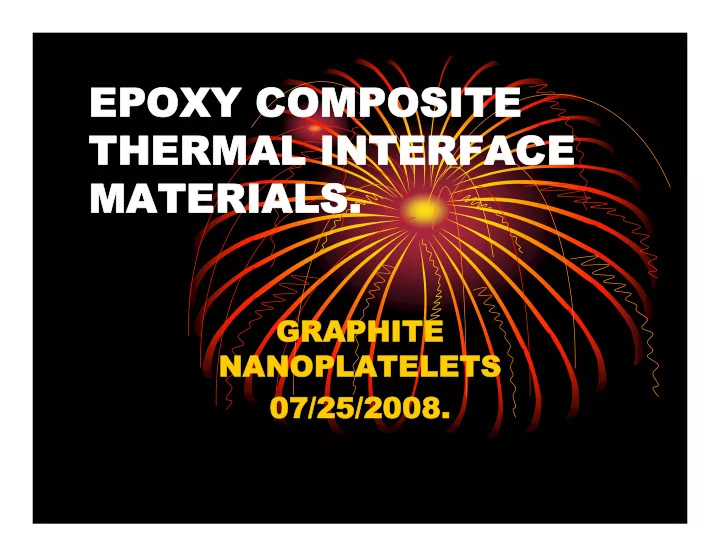

EPOXY COMPOSITE THERMAL INTERFACE MATERIALS. MATERIALS. GRAPHITE NANOPLATELETS 07/25/2008.
Side view of stacking graphite layer. • http://en.wikipedia.org/wiki/Grap hite • Graphite an allotrope of carbon, consists of superimposed lamellae of 2D carbon to carbon covalent networks referred to as graphene.
GRAPHITE LAYERS Graphite-layers-top-3D-balls Graphite ambient STM • http://en.wikipedia.org/wiki/Image:Graphite- layers-top-3D-balls.png
Preparation Preparation of of sample sample & & composite composite at at GATECH GATECH • Ig of micron sized graphite was added to 60ml ethanol & 20ml water, this was stirred sonicated for 24 hours. • The mixture was filtered and washed with distilled water for three times degassed & dried to obtain the sample. • The sample was then treated with 1:3 v/v of conc. nitric acid and sulphuric acid. This mixture was cooled and then sonicated for 2 days. After filtering a dry sample was obtained. • The composite was prepared with 828 epoxy of 5%,10%, 15%, & 20% by weight. • The composite was polished, cut and the thermal conductivity was measured using the thermal diffusivity and conductivity measuring apparatus.
Thermal Diffusivity and Conductivity LFA 447 Nano Flash - Xenon Flash Apparatus
Thermal Interface Material requires no heating. • Reworkable Loctite PowerstrateXtreme(TM), suited for use between heat sink and heat dissipating components, is supplied as free-standing film between 2 release liners. Compound flows at phase change temperature and conforms to surface features of heat sink and component. Upon flow, air is expelled from interface, thermal impedance is reduced, and product performs as thermal transfer material. It adheres to heat sinks and devices at room temperature • news.thomasnet.com
Electronics industry needs for improved performance of thermal interface materials (TIMs) are driving continued reductions in thermal resistance. These reductions are being achieved with materials that become liquidous or near- liquidous at predictable operating temperatures, with extremely high thermal conductivity filler materials, or with both . • left) Figure 1. Typical IC package construction identifying TIM1 and TIM2 placement for bare die package ( and lidded package (right).
Uses of graphite
REFERENCES • Gien A.K & Novoselov, K.S. The rise of graphene, Nature Mater.6. 183-191(2007). • Fukushima, H, Drzal,L.T., Rook, B.P. & Rich, M. J. Thermal Conductivity of exfoliated graphite nanocomposites, J. Therm, Anal. Cal. 85, 235-238 (2006). • Yu, A. Ramesh P., Itkis, M. E, Bekyarova, E. & Haddon R.C. Graphite nanoplatelat epoxy composite thermal interface materials, J. Phys. Chem, 7565-7569 (2007). • Hung M-T, Choi, o., Ju, Y.S. & Hahn, H. T. Heat conduction in graphite nanoplatelet reinforced polymer nanocomposites. Appl. Phys. Lett. 89, 023117/1-023117/3 (2006).
ACKNOWLEDGEMENTS: ACKNOWLEDGEMENTS: • Supervising Professor: Dr C.P.Wong C.P.Wong • Graduate Advisor: Wei Wong And Q Z liang • Step-Up Advisor: Dr Leyla Conrad • Step-up Advisor: Dr Edward C Conrad
Recommend
More recommend